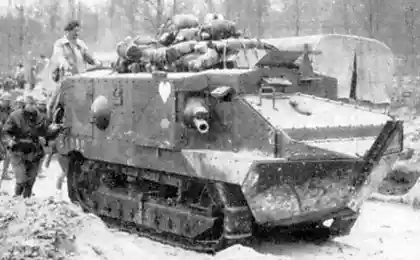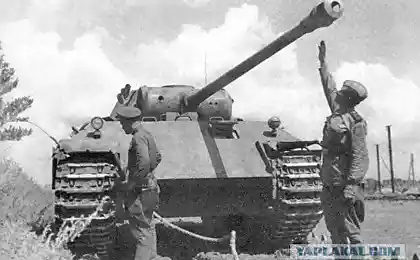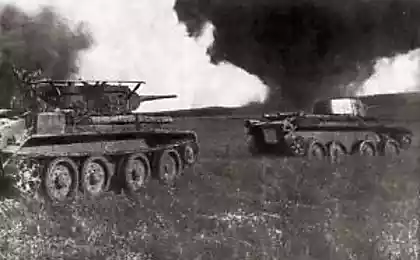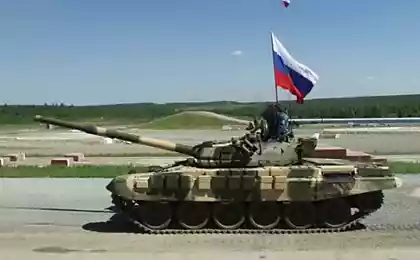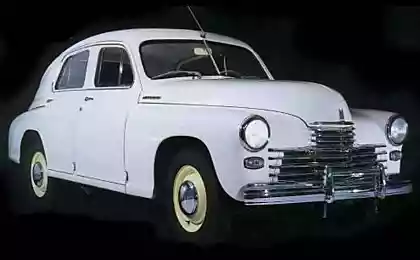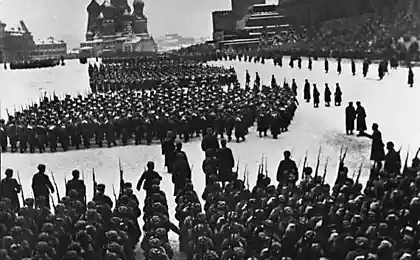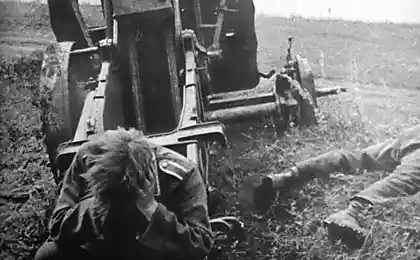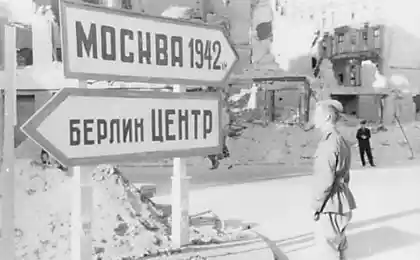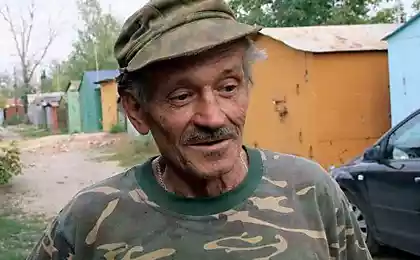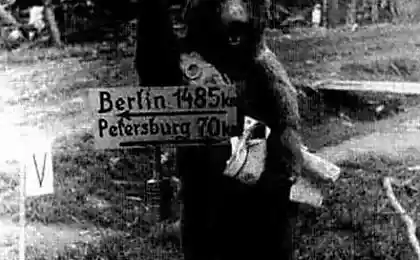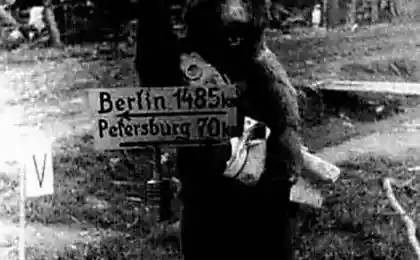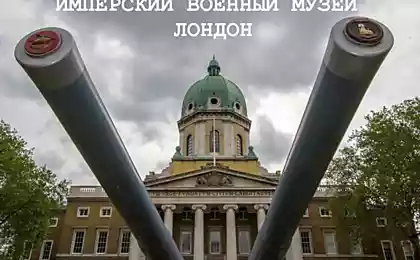1462
Tanks Our Victory
A lot of pictures. How to finish - I will tell.
Small tanks T-38 used in combat during the campaign in Western Ukraine and Belarus, during the war with Finland in the beginning of the Great Patriotic War.
The T-40. December 19, 1941 adopted a tank. Order for 1940 amounted to 100 machines, but the plant was able to make only 41. Until June 22, 1941 has produced 181 car. Thus, at the beginning of the war the Red Army had 222 tanks T-40.
During the first battles it became apparent lack of armament. In the summer of 1941, T-40 established 20-mm aircraft gun with ammunition ShVAK 154 shots, while eliminating the propeller and drive. The latter fact accelerated the process of production, and in a real combat situation virtually floating tank was not necessary. This option was designated T-40S ("S" - land).
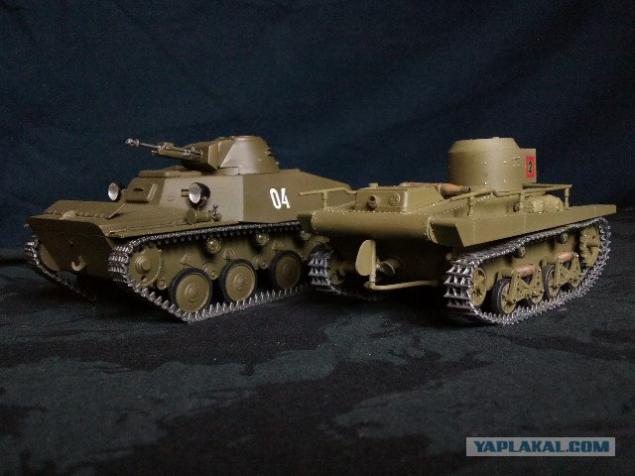
Tank T-50 in its armor protection and firepower superior light and medium tanks, most other countries. For tank support infantry speed was quite sufficient, to the shortcomings of the machine could carry a small stock of progress and constraints jobs four crew members. This disadvantage is eliminated by removing the second sample tank exchange machine gun DS and closing its armor recess lid screwed. In addition, neobrezinennye lightweight road wheels were replaced by rubber-coated. About the fate of the battle tanks T-50, very little is known. Combat vehicles manufactured in Leningrad, were armed with one of the armored brigades that operated in the Karelian Isthmus.

T-26 was designed for close support of infantry in a part of infantry units (battalion of T-26 was a member of a number of infantry divisions) and further support as part of the motorized infantry divisions, as well as for independent tactical and operational objectives.
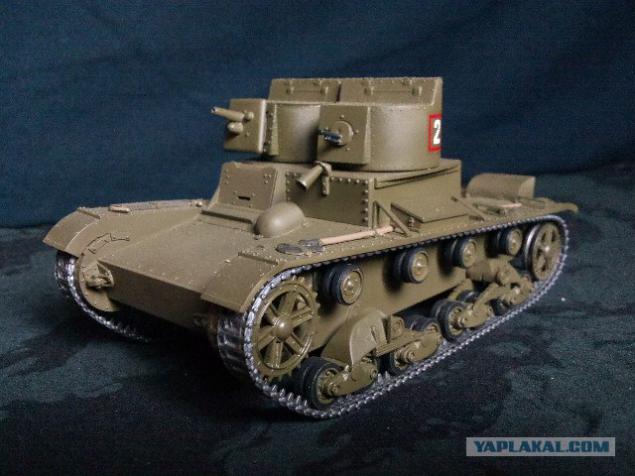
From 1941 to early 1943 they released the 5915 T-60. "Shestidesyatki" operated by the one of the three tank battalions in armored brigades mixed organization and actively used in battles in 1941-1942. A number of these machines as part of the tank units of the Leningrad Front took part in the battle to lift the siege of Leningrad in the winter 1944.
"Semidesyatki" operated by the tank brigades and regiments, the so-called mixed organization, together with the T-34, and after the termination of the fall of 1943 their production is mainly used in the self-propelled artillery battalions, regiments and brigades SU-76 as a command vehicle. In addition to the Red Army, the T-70M tanks armed with the Polish Army and the Czechoslovak Corps. Altogether during the serial production of the factory shop left 8226 light tanks T-70 and T-70M.
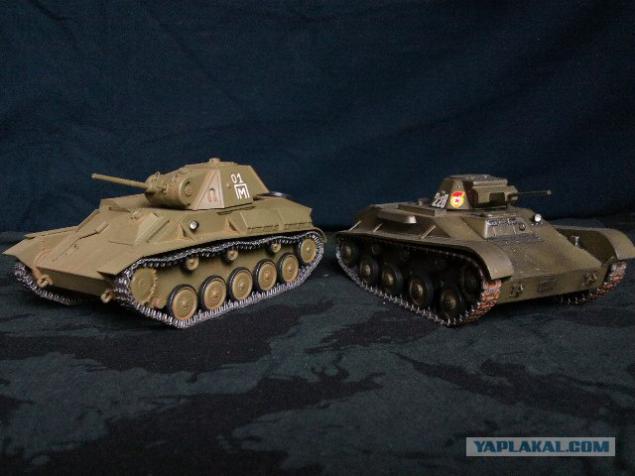
BT-7 tank line (1935-1939.). Armament: 45-mm tank gun of the sample 1932-1934. and 1 (2) machine gun DT (1937 produced version with tapered tower)

T-28 arrived on arms of separate tank regiments RGC, which in December 1935 had been deployed in some heavy tank brigades. The brigade, there were 54 tanks. Two teams - 10th and 20th, were armed with tanks T-28, took part in the fighting on the Karelian Isthmus during the war with Finland in 1939-1940. By 1941, T-28 tanks in terms of design ideas have become obsolete, even though on arms surpassed all the German tanks of the time, and for armor protection conceded only tank PzKpfw IV. They took part in combat operations in the initial period of the Great Patriotic War, and almost all were lost in the first months of battles. The surviving cars were involved in some fights up until 1944.
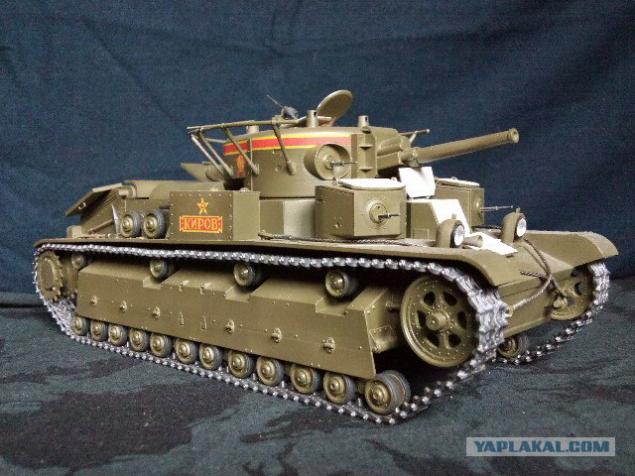
T-35 heavy tank (1935-1937.). Armament: 76, 2-mm tank gun RT-28, two 45-mm tank gun model 1932 and 7 machine-guns. T-35 was in service with the Red Army in 1936 and mass-produced until 1939.

He removed but with the board.

HF. It should be noted that the tank itself KB - machine rather contradictory fate. Paradoxical as it may sound, but in 1941, this tank was not necessary - it just was not a worthy opponent. No clear combat advantage over the average T-34, except thicker armor, he had not. Armament was the same maneuverability as worse than "Thirty." Tankers are not very fond of this car: KB three sheets could break either way (wheeled vehicles to follow him could not), it could not stand virtually no bridge, except for the capital of stone. But the main drawback was extremely unreliable in the main clutch, transmission, steering clutches and inefficient air cleaner. In short, the mission of the tank was not very good, its exit from the building was a mass phenomenon.
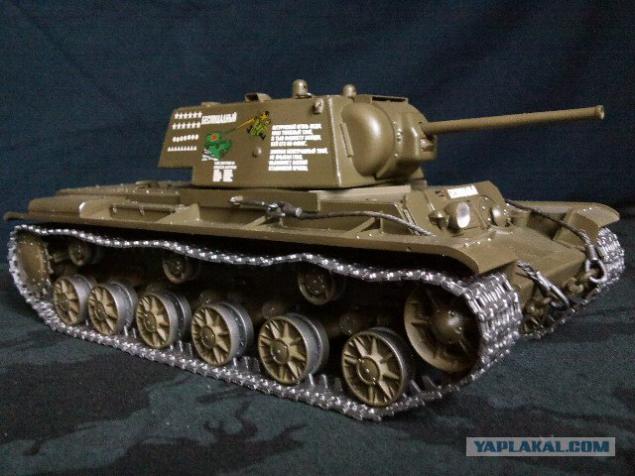
The main difference between the KV-2 consisted in the installation of a new tower large size. Overall height it reached 3240 mm. The tower, in the mask outside the closed armored casing, located 152 mm Tank Howitzer M-10, the 1938/40 sample and coaxial machine gun DT. In the rear part there was a door, next to which was placed in a ball bearing another DT. The tank also kept exchange machine gun in front hull.
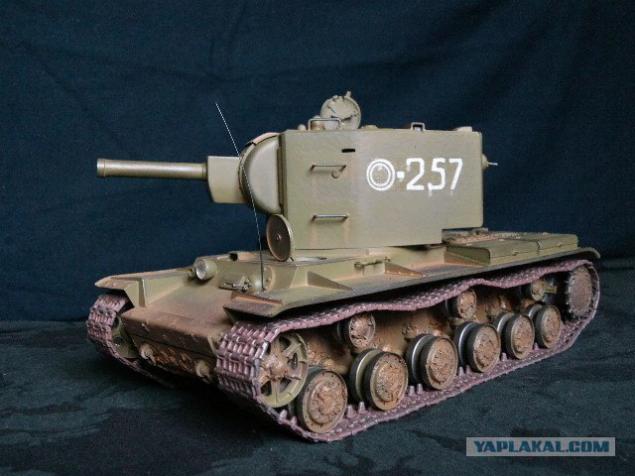
KV-85. These machines have been mastered late, was released them a little, and make a significant contribution to the fight against German heavy tanks they could not. A more serious opponent for the "Tigers" could become the HF-122 - serial KV-85, armed with an experimental basis in 122-mm gun D-25T. But at this time the shop CHKZ already started to leave the first series of tanks IP. These machines, at first glance, continues the line of KB, was brand new tanks, which by their fighting qualities far superior to the heavy enemy tanks.
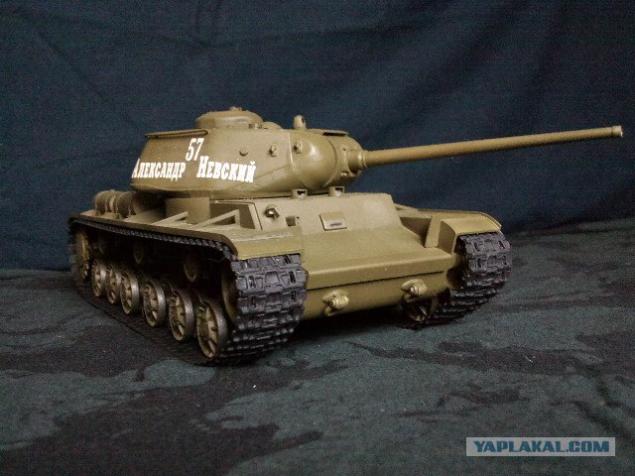
JS-2 arrived on arms of separate heavy tank regiments, which has assigned a name in the formation of "Guards". In early 1945, it was formed several separate Guards heavy tank brigades, which included three heavy tank regiment each. IS-2 was first applied in the Battle of the Korsun-Cherkassy Pocket and then took part in all operations of the final period of the Great Patriotic War.
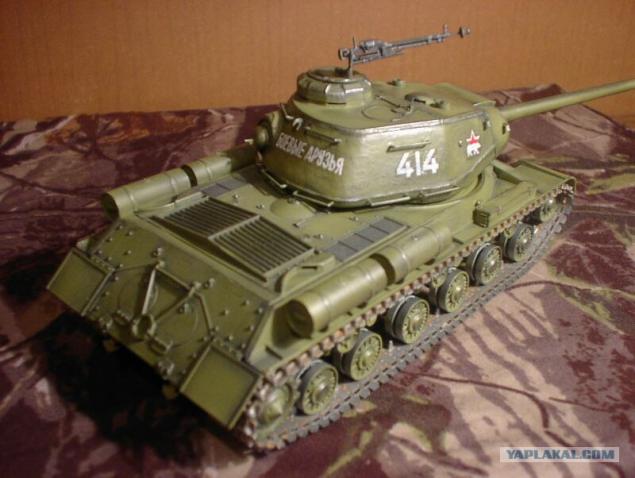
Pretty boy!
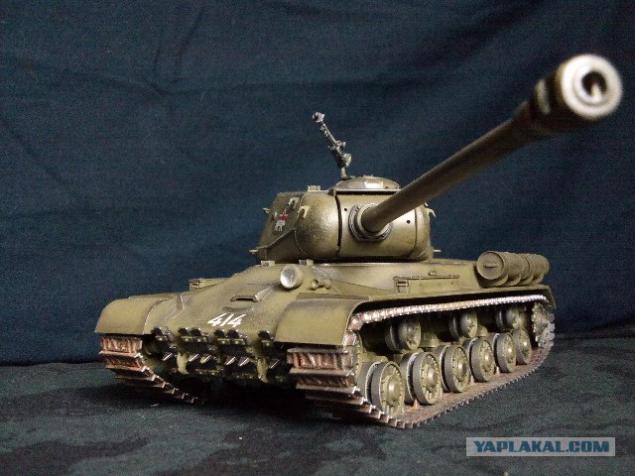
The last tank, created during the Great Patriotic War became a heavy IS-3 (object 703). It was designed in 1944-1945 at the pilot plant number 100 in Chelyabinsk under the leadership of chief designer MF BAL. Series production began in May 1945, during which was released in 1170 fighting vehicles. JS-3, contrary to popular opinion, is not used in the fighting of World War II, but the September 7, 1945 a tank regiment, armed with which consisted of these combat vehicles, participated in the parade of the Red Army in Berlin in honor of the victory over Japan, IS-3 and made a strong impression on the Western allies of the USSR anti-Hitler coalition.
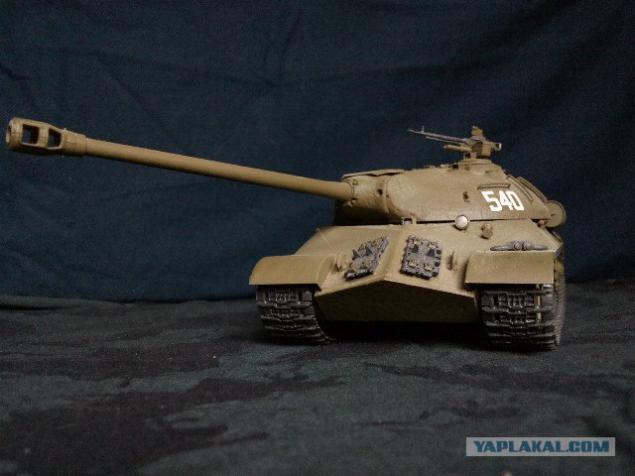
ISU-152
Heavy Soviet self-propelled artillery played a huge role in achieving victory. They are well proven during street fighting in Berlin and in the storming of the powerful fortifications of Konigsberg.
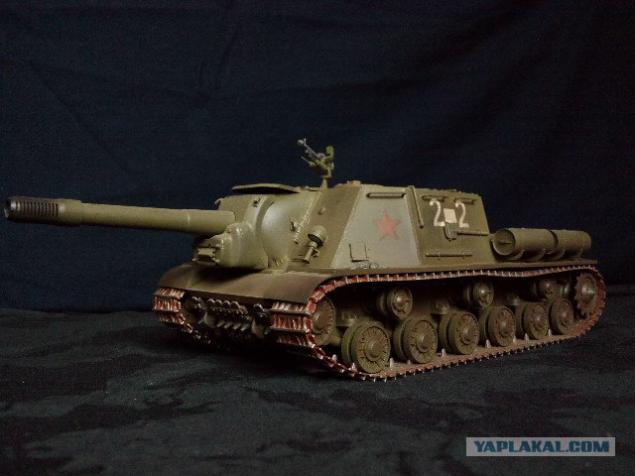
T-34-76 were in service in the tank units of the Red Army all the Great Patriotic War and participated in almost all military operations, including the storming of Berlin. In addition to the Red Army, the average T-34 tanks operated by the Polish Army, People's Liberation Army of Yugoslavia and the Czechoslovak Corps, which fought against Nazi Germany.
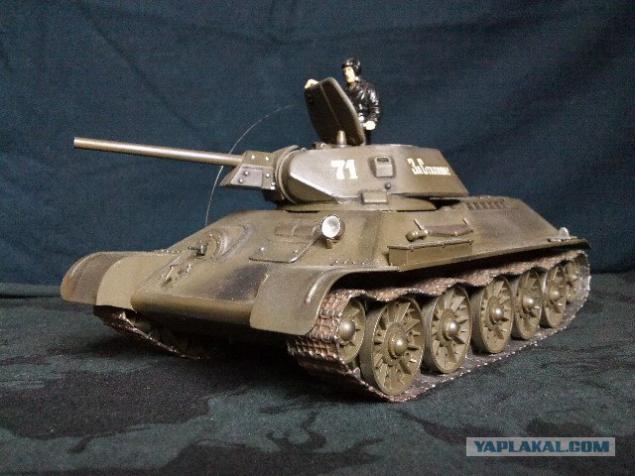
T-34 mod 43g.
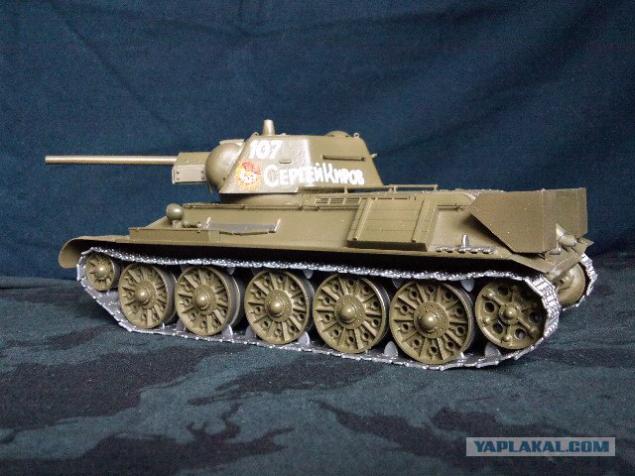
T-34 obr.44 city and the German Cancer-40.
T-34-85 took part in the final operations of the Great Patriotic War and the defeat of the Kwantung Army. They formed the basis of the tank park of the Soviet Army in the early postwar years.
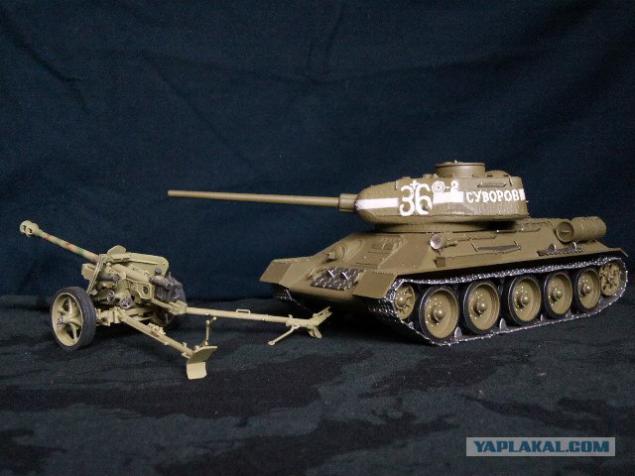
In addition to the Red Army in the years 1944-1945 a number of tanks T-34-85 received the Polish Army and the Czechoslovak Corps.

And that's what I will not tell you
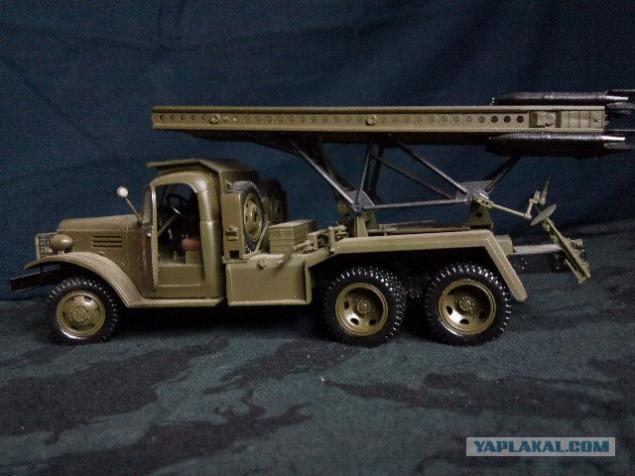
Well as it feared!
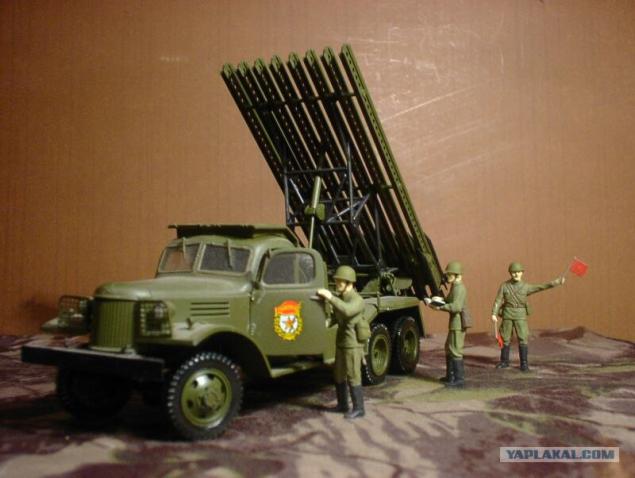
"Scouts" were delivered to almost all US allies in the anti-Hitler coalition. They are operated by the British Canadian and the Australian Army, the Free French forces, the Polish Armed Forces in the West, Belgian and Czechoslovakian parts. In the Soviet Union under the Lend-Lease Act were delivered to 3,340 armored M3A1. "Scouts" became the most widespread and the most popular Red Army armored personnel carriers. They were used as well as in the allied forces, mainly as reconnaissance and staff. Soviet Army M3A1 consisted until 1947 and served as a prototype for the development of direct light armored personnel carriers BTR-40.
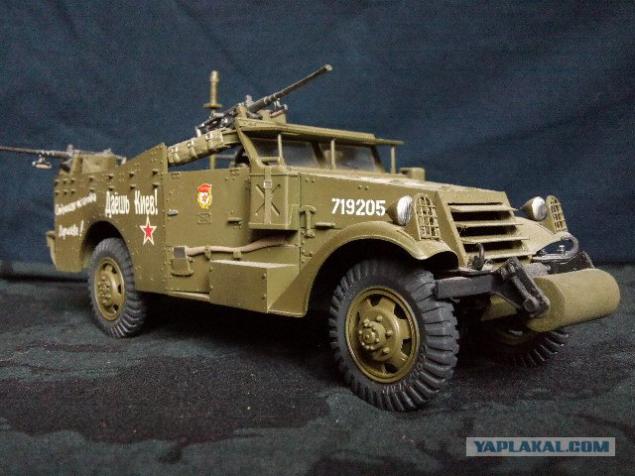
Typically, work on creating the first mass of the German tank Pz. I and Pz. II is associated with the coming to power of the Nazis. This is not entirely true. Yet in 1931 the inspector of motor forces of the Reichswehr Major General Oswald Lutz advanced the project of formation of tank units, while appreciating the progress made by the time the results of the construction of tanks in Germany as unsatisfactory. Was heavily influenced by his Chief of Staff Lieutenant-Colonel Heinz Guderian, he gave an indication to begin drafting a tank weighing 5,000 kg to be used for educational purposes (only indulgence of the Versailles Treaty). Until now, for that the troops used wooden models of tanks, mounted on cars.
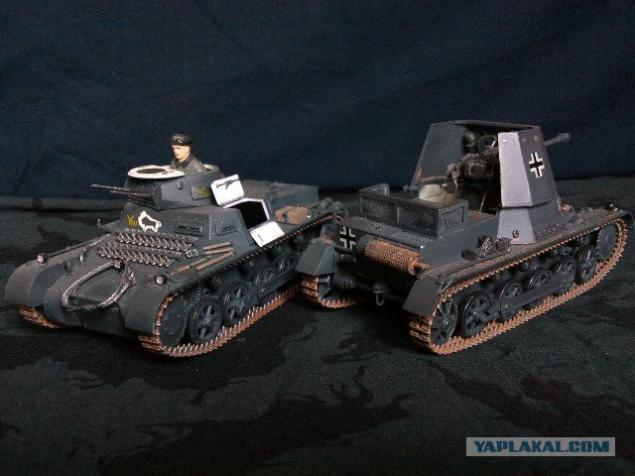
T-1 and on its self-propelled base.
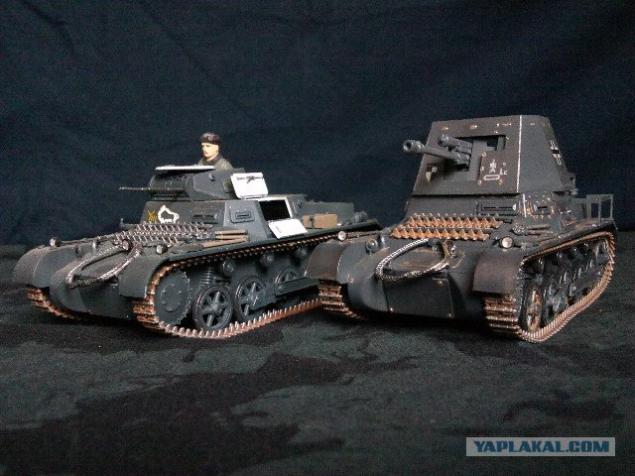
T-1 "Bear" was created specifically to deal with the guerrillas in the last two years of the war.
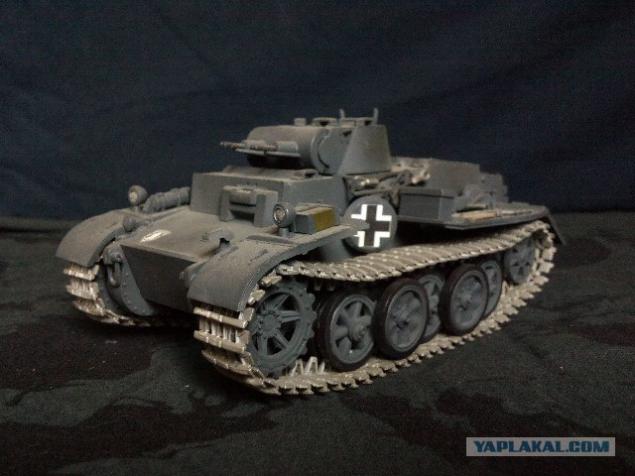
By the beginning of World War II tanks PzKpfw I and PzKpfw II were the massive tanks of the Wehrmacht. As of September 1, 1939 in the German army, there were just over 3,000 tanks, 1,445 of them in 1223 PzKpfw I and PzKpfw II.
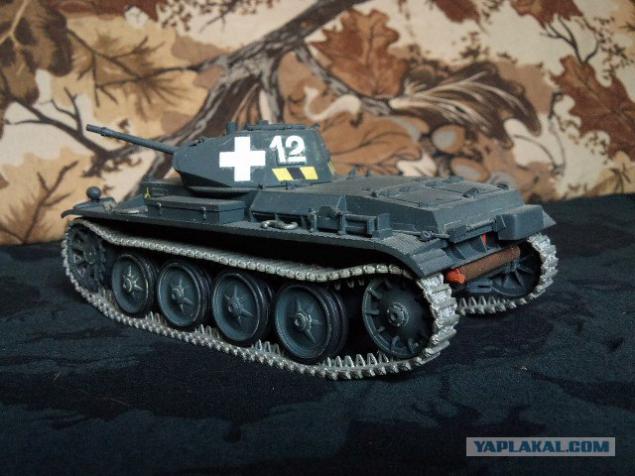
Based on the chassis of the T-2 was established flamethrower modification «F» - Flamingo.

The most perfect embodiment of "two" was his last modified L & quot; Lynx & quot ;. In essence, this was a new tank, as he had other housing tower chassis and staggered rollers. The latter was due to the strengthening of booking and installing a more powerful engine. "Luchs" was a reconnaissance tank, has high speed and maneuverability thanks to the wide tracks. In 1943 it was issued 133 machines of this type that have been used as part of the intelligence units of armored divisions.
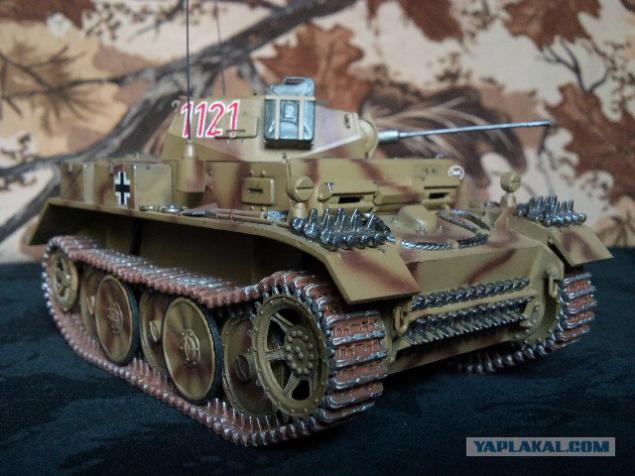
T-3
The layout of the tank was traditional for the Germans - with front-transmission, which reduces the length and increased the height of the machine, simplifies the design of drive control and maintenance. In addition, the prerequisites for increasing the size of the crew compartment.
Characteristic for the body of the tank, as, indeed, for all German tanks of the period, was the uniform strength armor plates on all main planes and an abundance of manholes. Until the summer of 1943 the strength of the housing Germans prefer the convenience of access to the units.
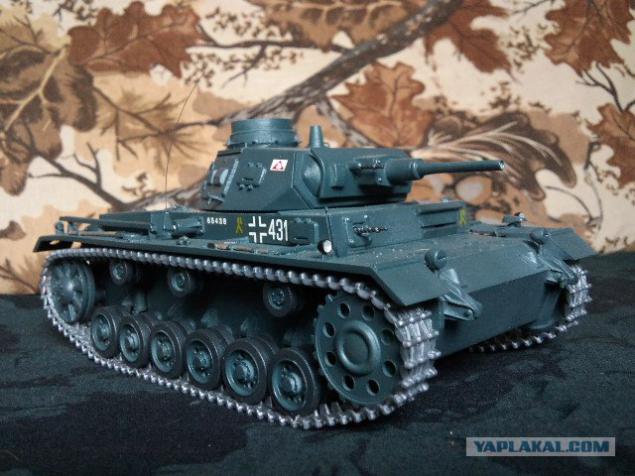
Later treshka

ACS StuG III was the most massive tracked armored vehicle of the German army in World War II. After the weapons in 1942. 75-mm long gun became, in essence, the main anti-tank weapons of the Wehrmacht

Attacking September 1, 1939 to Poland, the German army had already had 211 machines Pz IV, during the fighting commanders assessed the tank, and it was approved along with Pz III as a major. Since December 1939 it unfolded its mass production.

When Hitler attacked the Soviet hordes, immediately revealed the weakness of the arms Pz IV. In front of our T-34s this machine was completely powerless, so the Germans decided to urgently establish a long-barreled gun on it and strengthen booking, thus somehow equalize the Pz IV with PZ 34. In the spring of 1942 Pz IV armed with the new 75-mm cannon length 43 caliber (piercing projectiles had its initial velocity 990 m / s and 500 m past the 108-mm armor).

In 1943, a prototype assault gun built on the chassis of PzKpfw IV medium tank with elements booking assault gun StuG 40. December 6, Hitler ordered to begin mass production of the new self-propelled guns.
Since December 1943 ACS StuG IV produced by enterprises of the company "Nibelung" and on January 1944 - and factories firm "Krupp". Were built in 1108 series machines, there are 31 self-propelled guns in the restructuring line of tanks.
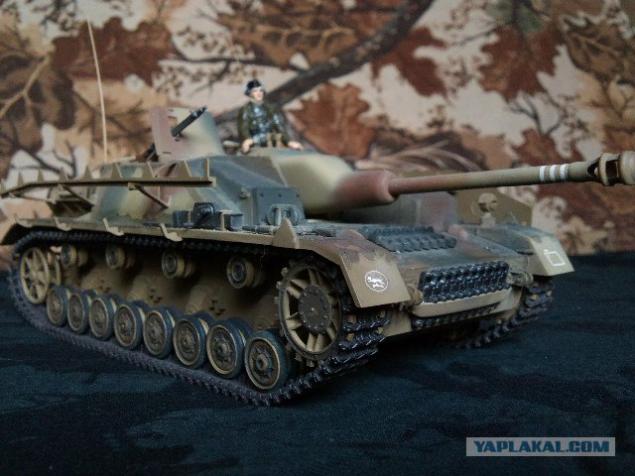
Total from May to November 1944 had produced only 44 Ostwind (from July 1944 to March 1945). They were a part of Flugabwehrzug (AA platoons) armored divisions. The tank was very effective against low-flying targets. An interesting fact is the test of a prototype of Ostwind combat as part of the 1st Armored Division Waffen SS «Leibstandarte SS Adolf Hitler» during the offensive in the Ardennes (from 16 to 22 December 1944), and return it to the factory without any damage. There were plans to increase the firepower Ostwind.

I wonder how in the rain?
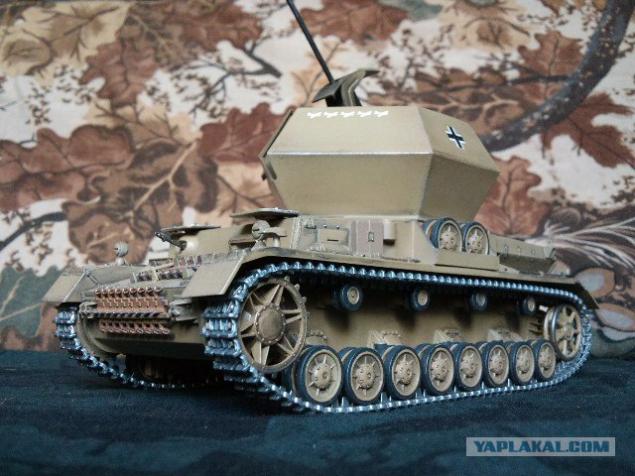
Of course, the "Panther" - one of the most famous heavy tanks, took part in World War II. The catalyst for the creation of which is not provided in the tank weapons of the Wehrmacht war machine became a Soviet medium tank T-34. His appearance on the Eastern Front forced the Ministry of arms of Germany to suspend the work, which in 1937 led the company Henschel tank of promising 30-ton class. The company Rheinmetall 18 July 1941 received an order to develop long-barreled 75-mm cannon, capable of penetrate 140 mm armor at a distance of 1000 m. The companies Daimler-Benz and MAN 25 November were, in turn, issued orders for the 35-ton tank. The performance requirements for new combat vehicle made the following: width up to 3150 mm, height 2990 mm, 650 engine capacity of 700 hp, 40 mm armor protection, the maximum speed of 55 km / h.
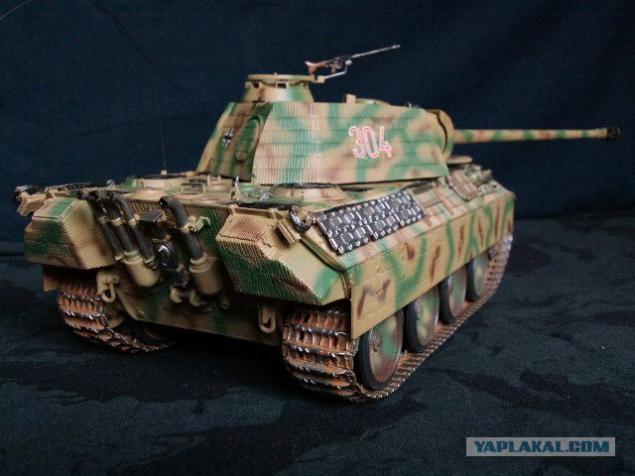
In 1943 he started designing another modification "Panthers» -Ausf.F, which is significantly different from previous models. The most important innovation was the tower, dubbed Schmalturm («narrow" or "close the tower"), which was less than the standard and had a different design.
In the course of 1944 it constructed and tested several prototypes. Designing ended only in January 1945.
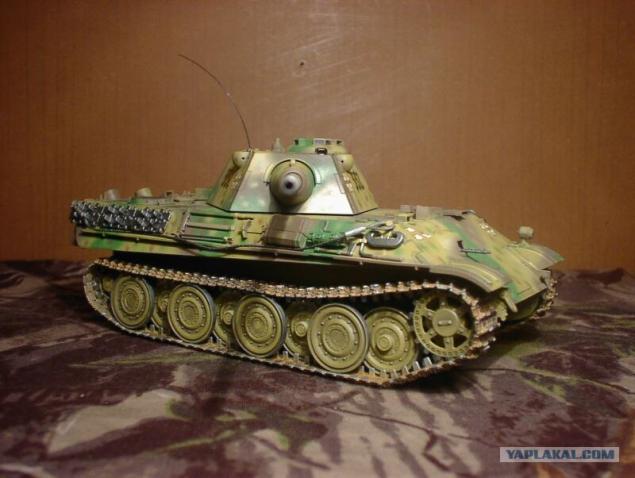
She is.
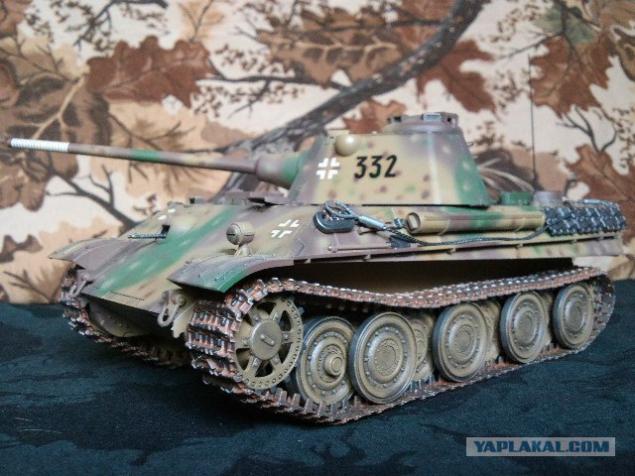
Jagdpanther (Jagdpanther), was by far the best one for this conversion tank Pz.Kpfw V Panther, moreover, it has become the most successful tank destroyer of World War II, is superior in armor protection all Soviet ACS, and in all respects all ACS allies. These days, a lot of copies jagdpanther preserved in museums around the world, the samples are thoroughly researched and written a large number of monographs. Nevertheless, an excellent tank destroyer did not leave a visible trace in the campaigns in the Eastern and Western fronts, which may explain the small number of cars produced, and overcoming manufacturing defects only in the last 30-40% of the outstanding samples.
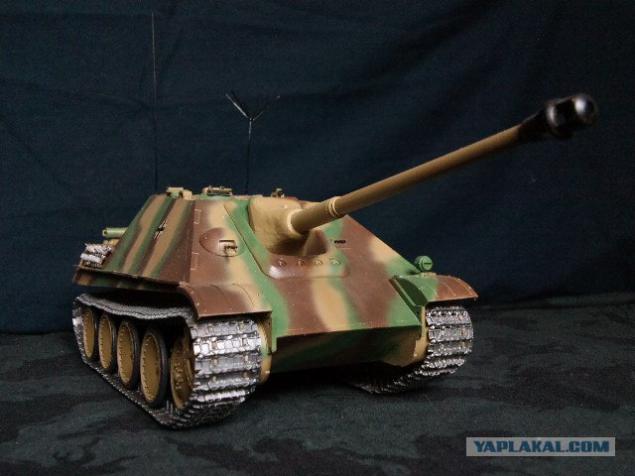
The prototype "Tiger" from Porsche. In the series, this machine did not go, and the chassis 50 have been started up for the production of self-propelled guns & quot; Ferdinand & quot ;.
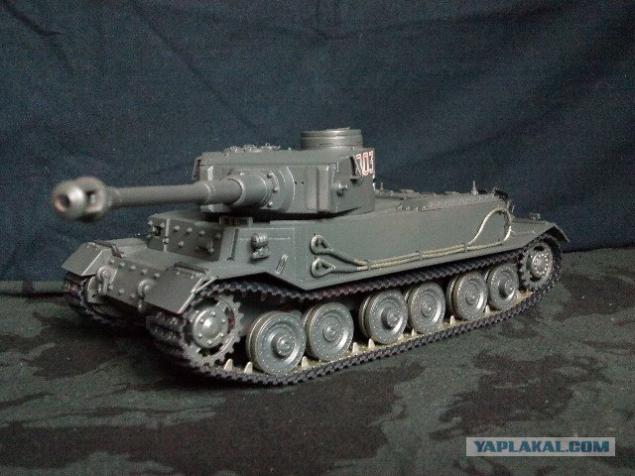
Baptism of fire "Ferdinands" taken during the operation "Citadel" as part of 656 Regiment tank destroyers, which included the 653rd and 654 th battalions (schwere Panzerjager Abteilung - sPz.Jager Abt.). Particularly heavy losses suffered 654 th Division mainly in the minefields. On the battlefield remained 21 "Ferdinand." Damaged and destroyed in the station area Ponyri German engineering surveyed July 15, 1943 representatives of the GAC and NIBTPoligona Red Army. Most of the "Ferdinand" was a minefield, packed with land mines captured from large-caliber shells and bombs. More than half of the cars were damaged chassis: caterpillar broken, destroyed road wheels, etc. Five "Ferdinand" undercarriage damage were caused by shells hit 76-mm caliber or more. Two German self-propelled guns guns guns appeared shot through with bullets and missiles antitank guns. One machine was destroyed by a direct hit bombs, and another one - hit 203 mm howitzer shell in the roof of the cabin.
Only one type of self-propelled guns, which fired from different directions a family of T-34 tanks and a battery of 76-mm guns, had a hole in the board, in the area of the drive wheel. Another "Ferdinand" had no damage to the hull and running gear was set on fire by a Molotov cocktail thrown by our infantry.
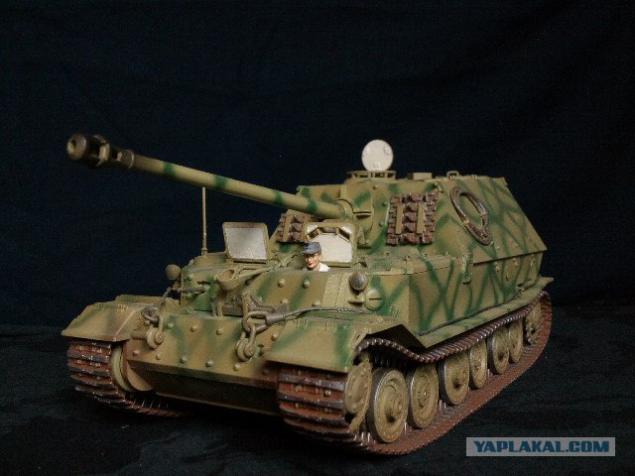
So Tiger said in a negligee))
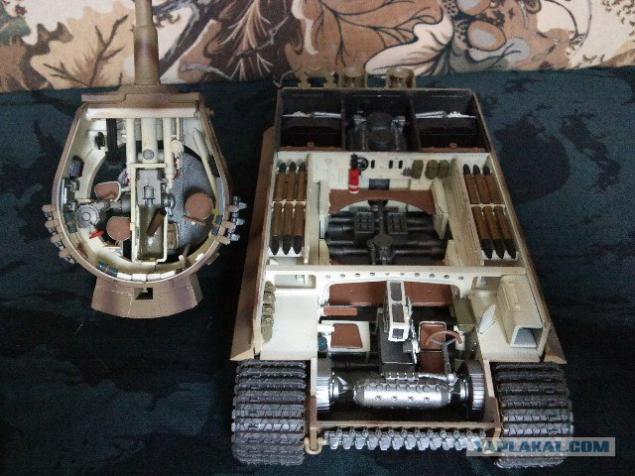
"Tiger", "Tiger", "Tigris" - is a word spoken in Russian, English, Polish, French soldiers armies of the coalition, forcing the heart beat faster, if not fear, the feeling of mortal danger. At this moment in the mind of the soldier arose not face ferocious striped cat, and the image of impregnable steel hulks spewing fire and death.

The reasons for the total failure of "royal tigers", did not meet the expectations of the Germans near Sandomierz became skillful organization of defense and, undoubtedly, the skill of our soldiers. On the other hand, the enemy brought numerous miscalculations in planning and tactics, bad choice of directions for use of heavy tanks, especially the 70-ton "royal tigers".
All!
Source:
Small tanks T-38 used in combat during the campaign in Western Ukraine and Belarus, during the war with Finland in the beginning of the Great Patriotic War.
The T-40. December 19, 1941 adopted a tank. Order for 1940 amounted to 100 machines, but the plant was able to make only 41. Until June 22, 1941 has produced 181 car. Thus, at the beginning of the war the Red Army had 222 tanks T-40.
During the first battles it became apparent lack of armament. In the summer of 1941, T-40 established 20-mm aircraft gun with ammunition ShVAK 154 shots, while eliminating the propeller and drive. The latter fact accelerated the process of production, and in a real combat situation virtually floating tank was not necessary. This option was designated T-40S ("S" - land).

Tank T-50 in its armor protection and firepower superior light and medium tanks, most other countries. For tank support infantry speed was quite sufficient, to the shortcomings of the machine could carry a small stock of progress and constraints jobs four crew members. This disadvantage is eliminated by removing the second sample tank exchange machine gun DS and closing its armor recess lid screwed. In addition, neobrezinennye lightweight road wheels were replaced by rubber-coated. About the fate of the battle tanks T-50, very little is known. Combat vehicles manufactured in Leningrad, were armed with one of the armored brigades that operated in the Karelian Isthmus.

T-26 was designed for close support of infantry in a part of infantry units (battalion of T-26 was a member of a number of infantry divisions) and further support as part of the motorized infantry divisions, as well as for independent tactical and operational objectives.

From 1941 to early 1943 they released the 5915 T-60. "Shestidesyatki" operated by the one of the three tank battalions in armored brigades mixed organization and actively used in battles in 1941-1942. A number of these machines as part of the tank units of the Leningrad Front took part in the battle to lift the siege of Leningrad in the winter 1944.
"Semidesyatki" operated by the tank brigades and regiments, the so-called mixed organization, together with the T-34, and after the termination of the fall of 1943 their production is mainly used in the self-propelled artillery battalions, regiments and brigades SU-76 as a command vehicle. In addition to the Red Army, the T-70M tanks armed with the Polish Army and the Czechoslovak Corps. Altogether during the serial production of the factory shop left 8226 light tanks T-70 and T-70M.

BT-7 tank line (1935-1939.). Armament: 45-mm tank gun of the sample 1932-1934. and 1 (2) machine gun DT (1937 produced version with tapered tower)

T-28 arrived on arms of separate tank regiments RGC, which in December 1935 had been deployed in some heavy tank brigades. The brigade, there were 54 tanks. Two teams - 10th and 20th, were armed with tanks T-28, took part in the fighting on the Karelian Isthmus during the war with Finland in 1939-1940. By 1941, T-28 tanks in terms of design ideas have become obsolete, even though on arms surpassed all the German tanks of the time, and for armor protection conceded only tank PzKpfw IV. They took part in combat operations in the initial period of the Great Patriotic War, and almost all were lost in the first months of battles. The surviving cars were involved in some fights up until 1944.

T-35 heavy tank (1935-1937.). Armament: 76, 2-mm tank gun RT-28, two 45-mm tank gun model 1932 and 7 machine-guns. T-35 was in service with the Red Army in 1936 and mass-produced until 1939.

He removed but with the board.

HF. It should be noted that the tank itself KB - machine rather contradictory fate. Paradoxical as it may sound, but in 1941, this tank was not necessary - it just was not a worthy opponent. No clear combat advantage over the average T-34, except thicker armor, he had not. Armament was the same maneuverability as worse than "Thirty." Tankers are not very fond of this car: KB three sheets could break either way (wheeled vehicles to follow him could not), it could not stand virtually no bridge, except for the capital of stone. But the main drawback was extremely unreliable in the main clutch, transmission, steering clutches and inefficient air cleaner. In short, the mission of the tank was not very good, its exit from the building was a mass phenomenon.

The main difference between the KV-2 consisted in the installation of a new tower large size. Overall height it reached 3240 mm. The tower, in the mask outside the closed armored casing, located 152 mm Tank Howitzer M-10, the 1938/40 sample and coaxial machine gun DT. In the rear part there was a door, next to which was placed in a ball bearing another DT. The tank also kept exchange machine gun in front hull.

KV-85. These machines have been mastered late, was released them a little, and make a significant contribution to the fight against German heavy tanks they could not. A more serious opponent for the "Tigers" could become the HF-122 - serial KV-85, armed with an experimental basis in 122-mm gun D-25T. But at this time the shop CHKZ already started to leave the first series of tanks IP. These machines, at first glance, continues the line of KB, was brand new tanks, which by their fighting qualities far superior to the heavy enemy tanks.

JS-2 arrived on arms of separate heavy tank regiments, which has assigned a name in the formation of "Guards". In early 1945, it was formed several separate Guards heavy tank brigades, which included three heavy tank regiment each. IS-2 was first applied in the Battle of the Korsun-Cherkassy Pocket and then took part in all operations of the final period of the Great Patriotic War.

Pretty boy!

The last tank, created during the Great Patriotic War became a heavy IS-3 (object 703). It was designed in 1944-1945 at the pilot plant number 100 in Chelyabinsk under the leadership of chief designer MF BAL. Series production began in May 1945, during which was released in 1170 fighting vehicles. JS-3, contrary to popular opinion, is not used in the fighting of World War II, but the September 7, 1945 a tank regiment, armed with which consisted of these combat vehicles, participated in the parade of the Red Army in Berlin in honor of the victory over Japan, IS-3 and made a strong impression on the Western allies of the USSR anti-Hitler coalition.

ISU-152
Heavy Soviet self-propelled artillery played a huge role in achieving victory. They are well proven during street fighting in Berlin and in the storming of the powerful fortifications of Konigsberg.

T-34-76 were in service in the tank units of the Red Army all the Great Patriotic War and participated in almost all military operations, including the storming of Berlin. In addition to the Red Army, the average T-34 tanks operated by the Polish Army, People's Liberation Army of Yugoslavia and the Czechoslovak Corps, which fought against Nazi Germany.

T-34 mod 43g.

T-34 obr.44 city and the German Cancer-40.
T-34-85 took part in the final operations of the Great Patriotic War and the defeat of the Kwantung Army. They formed the basis of the tank park of the Soviet Army in the early postwar years.

In addition to the Red Army in the years 1944-1945 a number of tanks T-34-85 received the Polish Army and the Czechoslovak Corps.

And that's what I will not tell you

Well as it feared!

"Scouts" were delivered to almost all US allies in the anti-Hitler coalition. They are operated by the British Canadian and the Australian Army, the Free French forces, the Polish Armed Forces in the West, Belgian and Czechoslovakian parts. In the Soviet Union under the Lend-Lease Act were delivered to 3,340 armored M3A1. "Scouts" became the most widespread and the most popular Red Army armored personnel carriers. They were used as well as in the allied forces, mainly as reconnaissance and staff. Soviet Army M3A1 consisted until 1947 and served as a prototype for the development of direct light armored personnel carriers BTR-40.

Typically, work on creating the first mass of the German tank Pz. I and Pz. II is associated with the coming to power of the Nazis. This is not entirely true. Yet in 1931 the inspector of motor forces of the Reichswehr Major General Oswald Lutz advanced the project of formation of tank units, while appreciating the progress made by the time the results of the construction of tanks in Germany as unsatisfactory. Was heavily influenced by his Chief of Staff Lieutenant-Colonel Heinz Guderian, he gave an indication to begin drafting a tank weighing 5,000 kg to be used for educational purposes (only indulgence of the Versailles Treaty). Until now, for that the troops used wooden models of tanks, mounted on cars.

T-1 and on its self-propelled base.

T-1 "Bear" was created specifically to deal with the guerrillas in the last two years of the war.

By the beginning of World War II tanks PzKpfw I and PzKpfw II were the massive tanks of the Wehrmacht. As of September 1, 1939 in the German army, there were just over 3,000 tanks, 1,445 of them in 1223 PzKpfw I and PzKpfw II.

Based on the chassis of the T-2 was established flamethrower modification «F» - Flamingo.

The most perfect embodiment of "two" was his last modified L & quot; Lynx & quot ;. In essence, this was a new tank, as he had other housing tower chassis and staggered rollers. The latter was due to the strengthening of booking and installing a more powerful engine. "Luchs" was a reconnaissance tank, has high speed and maneuverability thanks to the wide tracks. In 1943 it was issued 133 machines of this type that have been used as part of the intelligence units of armored divisions.

T-3
The layout of the tank was traditional for the Germans - with front-transmission, which reduces the length and increased the height of the machine, simplifies the design of drive control and maintenance. In addition, the prerequisites for increasing the size of the crew compartment.
Characteristic for the body of the tank, as, indeed, for all German tanks of the period, was the uniform strength armor plates on all main planes and an abundance of manholes. Until the summer of 1943 the strength of the housing Germans prefer the convenience of access to the units.

Later treshka

ACS StuG III was the most massive tracked armored vehicle of the German army in World War II. After the weapons in 1942. 75-mm long gun became, in essence, the main anti-tank weapons of the Wehrmacht

Attacking September 1, 1939 to Poland, the German army had already had 211 machines Pz IV, during the fighting commanders assessed the tank, and it was approved along with Pz III as a major. Since December 1939 it unfolded its mass production.

When Hitler attacked the Soviet hordes, immediately revealed the weakness of the arms Pz IV. In front of our T-34s this machine was completely powerless, so the Germans decided to urgently establish a long-barreled gun on it and strengthen booking, thus somehow equalize the Pz IV with PZ 34. In the spring of 1942 Pz IV armed with the new 75-mm cannon length 43 caliber (piercing projectiles had its initial velocity 990 m / s and 500 m past the 108-mm armor).

In 1943, a prototype assault gun built on the chassis of PzKpfw IV medium tank with elements booking assault gun StuG 40. December 6, Hitler ordered to begin mass production of the new self-propelled guns.
Since December 1943 ACS StuG IV produced by enterprises of the company "Nibelung" and on January 1944 - and factories firm "Krupp". Were built in 1108 series machines, there are 31 self-propelled guns in the restructuring line of tanks.

Total from May to November 1944 had produced only 44 Ostwind (from July 1944 to March 1945). They were a part of Flugabwehrzug (AA platoons) armored divisions. The tank was very effective against low-flying targets. An interesting fact is the test of a prototype of Ostwind combat as part of the 1st Armored Division Waffen SS «Leibstandarte SS Adolf Hitler» during the offensive in the Ardennes (from 16 to 22 December 1944), and return it to the factory without any damage. There were plans to increase the firepower Ostwind.

I wonder how in the rain?

Of course, the "Panther" - one of the most famous heavy tanks, took part in World War II. The catalyst for the creation of which is not provided in the tank weapons of the Wehrmacht war machine became a Soviet medium tank T-34. His appearance on the Eastern Front forced the Ministry of arms of Germany to suspend the work, which in 1937 led the company Henschel tank of promising 30-ton class. The company Rheinmetall 18 July 1941 received an order to develop long-barreled 75-mm cannon, capable of penetrate 140 mm armor at a distance of 1000 m. The companies Daimler-Benz and MAN 25 November were, in turn, issued orders for the 35-ton tank. The performance requirements for new combat vehicle made the following: width up to 3150 mm, height 2990 mm, 650 engine capacity of 700 hp, 40 mm armor protection, the maximum speed of 55 km / h.

In 1943 he started designing another modification "Panthers» -Ausf.F, which is significantly different from previous models. The most important innovation was the tower, dubbed Schmalturm («narrow" or "close the tower"), which was less than the standard and had a different design.
In the course of 1944 it constructed and tested several prototypes. Designing ended only in January 1945.

She is.

Jagdpanther (Jagdpanther), was by far the best one for this conversion tank Pz.Kpfw V Panther, moreover, it has become the most successful tank destroyer of World War II, is superior in armor protection all Soviet ACS, and in all respects all ACS allies. These days, a lot of copies jagdpanther preserved in museums around the world, the samples are thoroughly researched and written a large number of monographs. Nevertheless, an excellent tank destroyer did not leave a visible trace in the campaigns in the Eastern and Western fronts, which may explain the small number of cars produced, and overcoming manufacturing defects only in the last 30-40% of the outstanding samples.

The prototype "Tiger" from Porsche. In the series, this machine did not go, and the chassis 50 have been started up for the production of self-propelled guns & quot; Ferdinand & quot ;.

Baptism of fire "Ferdinands" taken during the operation "Citadel" as part of 656 Regiment tank destroyers, which included the 653rd and 654 th battalions (schwere Panzerjager Abteilung - sPz.Jager Abt.). Particularly heavy losses suffered 654 th Division mainly in the minefields. On the battlefield remained 21 "Ferdinand." Damaged and destroyed in the station area Ponyri German engineering surveyed July 15, 1943 representatives of the GAC and NIBTPoligona Red Army. Most of the "Ferdinand" was a minefield, packed with land mines captured from large-caliber shells and bombs. More than half of the cars were damaged chassis: caterpillar broken, destroyed road wheels, etc. Five "Ferdinand" undercarriage damage were caused by shells hit 76-mm caliber or more. Two German self-propelled guns guns guns appeared shot through with bullets and missiles antitank guns. One machine was destroyed by a direct hit bombs, and another one - hit 203 mm howitzer shell in the roof of the cabin.
Only one type of self-propelled guns, which fired from different directions a family of T-34 tanks and a battery of 76-mm guns, had a hole in the board, in the area of the drive wheel. Another "Ferdinand" had no damage to the hull and running gear was set on fire by a Molotov cocktail thrown by our infantry.

So Tiger said in a negligee))

"Tiger", "Tiger", "Tigris" - is a word spoken in Russian, English, Polish, French soldiers armies of the coalition, forcing the heart beat faster, if not fear, the feeling of mortal danger. At this moment in the mind of the soldier arose not face ferocious striped cat, and the image of impregnable steel hulks spewing fire and death.

The reasons for the total failure of "royal tigers", did not meet the expectations of the Germans near Sandomierz became skillful organization of defense and, undoubtedly, the skill of our soldiers. On the other hand, the enemy brought numerous miscalculations in planning and tactics, bad choice of directions for use of heavy tanks, especially the 70-ton "royal tigers".
All!
Source:

